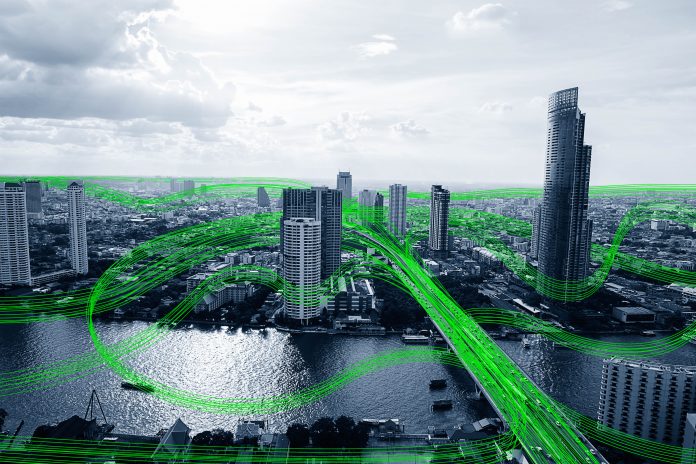Frank Stoecker, CEO and co-founder, EMnify, explores why the IoT and the future of smart cities depend on smart mobility as a key building block
Smart cities and smart city ideals are emerging as the bedrock of sustainable urban planning, offering high standards of living to residents. Smart mobility plays a central role in this emergence, delivering sustainable transportation and improving lives. Yet its success depends upon rapid, secure, reliable methods of connectivity.
Despite the expectations of the twentieth century, with the technological promise of The Jetsons, and the hit-and-miss prophecies of the BBC’s Tomorrow’s World, we’re not yet travelling around in flying cars or riding bicycles across bodies of water(1). Yet, with the accelerated rate of digitisation and the development of new technologies, some futuristic expectations are starting to crystallise on a citywide scale.
Smart cities are beginning to arrive in force, originating through trials and testing in Europe in the late 1980s and throughout the 1990s. From early forays that focused on information and communications initiatives, sustainable spaces, grid energy solutions and data capture using geographical information systems (GIS), a more cohesive smart infrastructure has started to spring forth.
Singapore’s Smart Nation vision aims to capture information throughout the city, using sensors linked to aggregation boxes, to deliver services based on traffic volumes and pedestrian activity. Its National Research Foundation is leading the development of Virtual Singapore, a dynamic 3D city model and collaborative data platform.
Oslo is addressing climate change with the wide use of sensors to control lighting, heating and cooling, with a goal to cut emissions by as much as 95% by 2030, as well as developing a smart grid, with widespread electric vehicle charging technologies.
Connected London is delivering full-fibre connectivity across the city, combining buildings with street assets such as lighting columns and bus stops to create a comprehensive grid of smart sensors and charging points. Small mobile transmitters for 5G are also being deployed to deliver citywide improvements to connectivity and future growth.
The three layers of a smart city
The future of the smart city is almost here. In many urban locations, the foundations have been poured into place. New development now depends upon three specific layers working together to make a smart city operate. According to McKinsey(2), the first layer is the technology, which requires a critical mass of smartphones and sensors connected by high-speed communication networks. The second layer is the applications, translating the constant stream of raw data into alerts, insights and action. And the third layer is all about getting buy-in and participation from members of the public.
For example, applications that show accurate traffic volume in real-time allow drivers and pedestrians to better plan travel routes and adapt at a moment’s notice. Being able to access insights like this builds bigger efficiencies as well as preventing further backup in the congested area. When the benefits can be conveyed to the population at large, all three layers are satisfied.
The role of connectivity
And it all begins with connectivity. Without connectivity, and without rapid, secure, reliable methods of data transmission, everything else begins to fall away. Secure, reliable connectivity also feeds into the third layer, ensuring buy-in and participation from the public. Without trust in the networks, rollouts will be compromised and projects will be prone to uncertainties. Smart cities can only work if their inhabitants can trust them.
That’s why availability, integrity, confidentiality and accountability need to be at the forefront of any network infrastructure. It’s the only way that all ecosystem partners can operate together within a transparent digital environment to achieve widely-accepted solutions. A sustainable network infrastructure needs:
- Availability, to ensure actionable, real-time data access, allowing information to be collected, analysed and shared at the speeds necessary for decision-making.
- Data integrity, to inform the smooth operation of a smart city. Without accurate and reliable data, decision-making becomes compromised.
- Confidentiality, to protect and anonymise inhabitants’ personal details and actions, preventing unauthorised access to confidential information.
- Accountability, to ensure system administrators and users at all levels are held responsible for their actions.
Built on these four data principles, the smart city becomes an economically sustainable urban development, delivering a high standard of living to its residents. And because the standard of living directly influences the quality of life, inhabitants can enjoy healthier, more fulfilled existences. From the quality of the air, to the time spent commuting, smart cities allow for a humanitarian approach to inhabitants’ welfare.
Connectivity as the solution to urban mobility
Many cities are in a transitional state, moving towards becoming smart cities. And many have implemented solutions to improve urban mobility for their inhabitants. That’s because mobility issues have been a major challenge in recent years. That could be due to high population densities, the difficulties of a pre-existing built environment, or simply for reasons of resource allocation. Smart mobility can alleviate much of the pressure. Also known as micromobility, smart mobility focuses on the use of small, lightweight personal vehicles with top speeds usually below 15mph. This includes privately owned and communal bicycles, e-bikes, electric scooters and electric pedal-assisted bicycles.
When inhabitants choose micromobility, there’s less reliance on cars, mopeds and motorcycles. This feeds directly into the smart city ideals of improved air quality and reduced commuting times. And for those without access to motor vehicles, it unlocks more of the city, making the world more enjoyable to live in.
Although technological advances in batteries and lightweight motors are forming the foundations of affordable, accessible micromobility, it’s still currently illegal to use a privately-owned e-scooter on public land in the UK. However, there are a number of e-scooter trials taking place across the UK, including London, where a 12-month trial began in June this year.
Micromobility for hire underlines the need for a smart connectivity infrastructure that allows potential users to locate and hire the closest vehicle. Connecting micromobility devices to the Internet of Things (IoT) allows the creation of this smart infrastructure, developing a system of interconnected elements that function within an ecosystem. The beginnings of an integrated traffic flow management and inhabitant mobility strategy begin to emerge. Micromobility’s two tangible components are the connected device and a smartphone. But the critical invisible component is connectivity.
There’s a lot riding on connectivity. Network coverage, quality and reliability issues can prevent inhabitants from connecting to scooters and other connected devices. Not only is cellular connectivity vital to the end-user, but it also allows operators to manage their fleets more effectively, collecting data points such as origin and destination, alongside the duration and distance of the trip. When these are combined with vehicle diagnostic data, it not only allows for tracking and availability but charging and predictive maintenance, too.
Beyond micromobility
Cellular IoT connectivity is the only choice for today’s micromobility solutions. It brings together connected transportation devices and smartphones within an ecosystem that can be harnessed for so much more. It is a critical and fundamental building block of the smart city. When harnessed correctly, the data gathered and acted upon has the potential to profoundly improve the quality of life for all inhabitants, as well as creating tangible economic opportunities through a wide range of beneficial projects.
From decreasing traffic congestion and improving air quality, to refining energy distribution and enhancing communal spaces, the connectivity at the heart of micromobility can influence the future direction of the smart city as a whole. Over the longer term, connectivity can be used to reshape the built environment, positively influencing town planning and urban development to maximise the smart city opportunity.
(1) The Guardian (2003) Tomorrow’s World: from breathalysers to paper pants https://www.theguardian.com/media/2003/jan/03/broadcasting.bbc
(2) McKinsey (2018) Smart cities: Digital solutions for a more livable future https://www.mckinsey.com/business-functions/operations/our-insights/smart-cities-digital-solutions-for-a-more-livable-future











